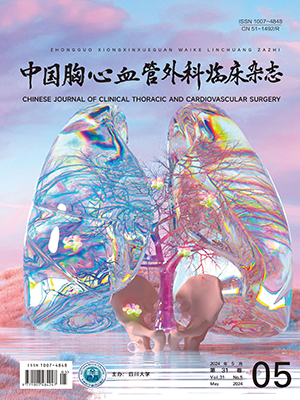| 1. |
Mao H, Katz N, Ariyanon W, et al. Cardiac surgery-associated acute kidney injury. Cardiorenal Med, 2013, 3(3):178-199.
|
| 2. |
Rosner MH, Okusa MD. Acute kidney injury associated with cardiac surgery. Clin J Am Soc Nephrol, 2006, 1(1):19-32.
|
| 3. |
王旭冬,车妙琳,谢波,等. 急性肾损伤定义及分期系统评估心脏手术患者预后的临床价值. 中国胸心血管外科临床杂志, 2012, 19(6):619-623.
|
| 4. |
Cosentino F, Chaff C, Piedmonte M. Risk factors influencing survival in ICU acute renal failure. Nephrol Dial Transplant, 1994, 9(Suppl 4):179-182.
|
| 5. |
Lecomte P, Van Vlem B, Coddens J, et al. Tight perioperative glucose control is associated with a reduction in renal impairment and renal failure in non-diabetic cardiac surgical patients. Crit Care, 2008, 12(6):R154.
|
| 6. |
Hauer D, Kilger E, Kaufmann I, et al. Risk and outcome analysis of renal replacement therapies in patients after cardiac surgery with pre-operatively normal renal function. Anaesthesia, 2009, 64(6):615-619.
|
| 7. |
Allen LA, Felker GM, Pocock S, et al. Liver function abnormalities and outcome in patients with chronic heart failure:data from the Candesartan in Heart Failure:Assessment of Reduction in Mortality and Morbidity(CHARM) program. Eur J Heart Fail, 2009, 11(2):170-177.
|
| 8. |
Bapat V, Sabetai M, Roxburgh J, et al. Early and intensive continuous veno-venous hemofiltration for acute renal failure after cardiac surgery. Interact Cardiovasc Thorac Surg, 2004, 3(3):426-430.
|
| 9. |
Kumar AB, Suneja M. Cardiopulmonary bypass-associated acute kidney injury. Anesthesiology, 2011, 114(4):964-970.
|
| 10. |
丁文军, 刘华, 季强, 等. 心脏术后急性肾损伤行连续性静脉-静脉血液透析治疗失败的危险因素分析. 中华医学杂志, 2013, 93(22):1737-1739.
|
| 11. |
Ji Q, Mei Y, Wang X, et al. Risk factors for failure of continuous veno-venous hemodialysis in the treatment of acute renal failure following cardiac surgery. Perfusion, 2010, 25(5):337-342.
|
| 12. |
Despotis GJ, Avidan MS, Hogue CW Jr. Mechanisms and attenuation of hemostatic activation during extracorporeal circulation. Ann Thorac Surg, 2001, 72(5):S1821-1831.
|
| 13. |
Ng RR, Chew ST, Liu W, et al. Identification of modifiable risk factors for acute kidney injury after coronary artery bypass graft surgery in an Asian population. J Thorac Cardiovasc Surg, 2014, 147(4):1356-1361.
|
| 14. |
王常田, 李德闽, 申翼, 等. 心血管手术后血小板的动态变化及其与患者预后的相关性分析. 解放军医学杂志, 2010, 35(9):1145-1147.
|
| 15. |
张丽琴, 邢昌赢, 林花, 等. 重症急性肾损伤患者经连续性肾脏替代治疗后肾功能恢复的影响因素. 现代生物医学进展, 2014, 14(8):1490-1493.
|
| 16. |
Bellomo R, Auriemma S, Fabbri A, et al. The pathophysiology of cardiac surgery-associated acute kidney injury(CSA-AKI). Int J Artif Organs, 2008, 31(2):166-178.
|
| 17. |
Carrel T, Englberger L, Mohacsi P, et al. Low systemic vascular resistance after cardiopulmonary bypass:incidence, etiology, and clinical importance. J Card Surg, 2000, 15(5):347-353.
|
| 18. |
Fischer GW, Levin MA. Vasoplegia during cardiac surgery:current concepts and management. Semin Thorac Cardiovasc Surg, 2010, 22(2):140-144.
|
| 19. |
Suen WS, Mok CK, Chiu SW, et al. Risk factors for development of acute renal failure(ARF) requiring dialysis in patients undergoing cardiac surgery. Angiology, 1998, 49(10):789-800.
|
| 20. |
徐静, 沈平雁, 马晓波, 等. CRRT 患者的 APACHE 评分及危险因素分析. 中国血液净化, 2010, 9(7):368-371.
|




